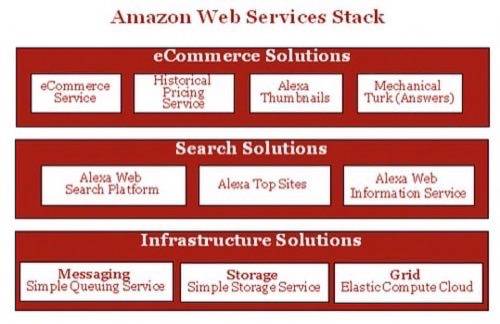Written by Alex Iskold and edited by
Richard MacManus.
WebOS services are going to be utilized by thousands of
companies – and will power the next generation of web applications. Amazon is at this
point leading the charge of the big Internet companies to capture this potentially huge
market.
There is a very long, but interesting, cover story in today’s BusinessWeek entitled Jeff Bezos’ Risky
Bet. The article focuses on the transformation of the e-commerce giant into a
software company. The growing stack of Amazon Web Services clearly points to a sea change
in the Seattle e-commerce giant. Indeed Amazon is beginning to look more like an
alternative Microsoft for the web computing era!
In short, Jeff
Bezos’ big bet is a bet on the software infrastructure of the Web. We here at
Read/WriteWeb think this is a visionary strategy by Amazon – and it is likely to pay
off…
Amazon completes its Web Services stack
In August, I wrote a series of articles about Amazon’s Web Services strategy for a Web
2.0 magazine. The article that summed up what Amazon is up to was called: Amazon – the Real Web Sevices
Company. Based on the piece in Business Week, it is clear that during the Web 2.0
conference next week, Amazon’s Web Services strategy will become official. As a software
engineer, I can’t hide my joy. This is indeed a triumph of software engineering – a large
company has managed to productize the pieces of its own infrastructure.
Not only that, but Amazon is very serious about making money on this endeavor. The web
giant is carefully and methodically rolling out the building blocks of its next
generation Web Platform. It started with the
Amazon eCommerce API and Alexa services. But not until the
Simple Storage Service rolled out, did it became clear that Amazon is building a full
web services stack. Here is our diagram showing what it looks like:

Web as a Platform
Amazon’s Web Services stack is evidence of a new computing paradigm, where web
services in aggregate give rise to a new web-based operating system. Like a classical
operating system, this new one has the key ingredients – infinitely scalable storage,
dynamic indexing service, adaptive grid, etc. These pieces, put together, provide a
compelling new way to think about application development. Amazon is actively working to
both define and implement the ingredients of this new Web Platform.
Why this makes sense
Building large-scale web software is a big challenge. Amazon solves this problem by
offering the infrastructure that has powered one of the biggest online stores for the
past decade. Amazon hides complexity behind simple, minimalist APIs and offers their
services for a very reasonable cost. The Amazon team takes the concepts of search,
storage, lookup and management of data – and turns them into pay-per-fetch and
pay-per-space web services.
To begin with, it’ll be small and medium businesses that take up Amazon’s services. As
Business Week points out, Wall Street is not going to jump on this. But the SmugMug photo service did and other startups and small
businesses will follow suit. So even if large corporations will not come, there is plenty
of money to be made. The Long Tail anyone?
What can we expect?
In the near term, we will probably see more services from Amazon which focus on
completing their Web Services stack. For example, S3 does not have querying capabilities
– which is a fairly big limitation. The elastic cloud is very powerful, but at the same
time complex – so we can expect additional offerings that simplify deployment and
management of the grid.
We are also likely to see other players entering the WebOS market. Google has already
made moves with its Google Base API and
is rumored to be working on the GDrive.
Microsoft also has Live Drive
in the works. Both Google and Microsoft are no doubt working on other web services
initiatives. Also watch out for smaller but more innovative players, like 3Tera – which we profiled in September.
Regardless of the provider, WebOS services are going to be utilized by thousands of
companies – and will power the next generation of web applications. Amazon is at this
point leading the charge of the big Internet companies to capture this potentially huge
market.
In upcoming posts, we will highlight the use cases for Amazon and other web services.
In the mean time, let us know if you’re currently using Amazon Web Services – and what
you think of the experience so far.
See Also:Web
Platform Primer – what’s available via API?; GData
API for Google Base released; Amazon
Launches Elastic Compute Cloud










